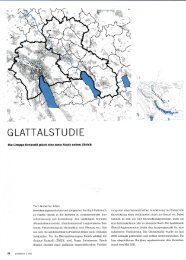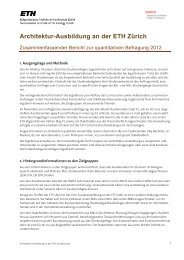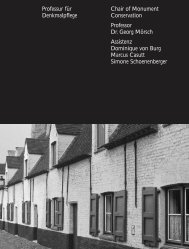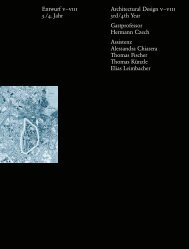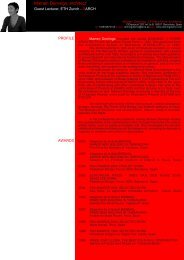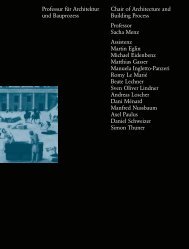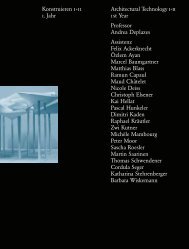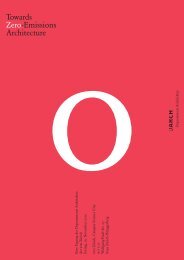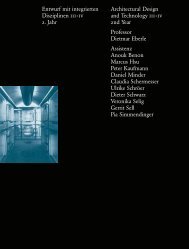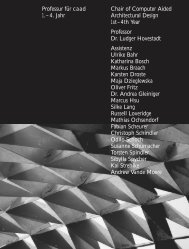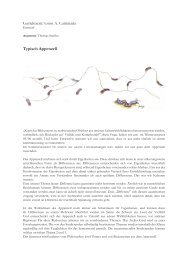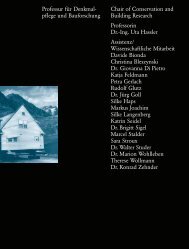Prof. Günther Vogt - ETH Zürich
Prof. Günther Vogt - ETH Zürich
Prof. Günther Vogt - ETH Zürich
Erfolgreiche ePaper selbst erstellen
Machen Sie aus Ihren PDF Publikationen ein blätterbares Flipbook mit unserer einzigartigen Google optimierten e-Paper Software.
Forschungsprojekt eth<br />
<strong>Zürich</strong>, nsl, Institut<br />
für Landschaftsarchitektur<br />
(ila), <strong>Prof</strong>. <strong>Günther</strong> <strong>Vogt</strong><br />
Berlin (Streetart)<br />
and<br />
Tokyo (Walking)<br />
Taking to the Streets<br />
Das Forschungsprojekt Taking to the Streets (seit April 2007)<br />
nimmt sich mit Leidenschaft eines Themas an, das allgemein<br />
nicht als sehr attraktiv betrachtet wird: der Strasse.<br />
Doch betrachten wir die Strasse nicht nur als Ort<br />
des Verkehrs, sondern vielmehr als Raum, und zwar als<br />
Lebensraum. Aus der Perspektive des Raums ist die<br />
Strasse immer auch öffentlicher Raum, Handlungs- und<br />
Bewegungsraum, performativer Raum, Raum der Kommunikation<br />
genauso wie subversiver Raum der politischen<br />
Äusserungen und künstlerischen Interventionen.<br />
Im Zentrum der Untersuchung steht nicht die grossmassstäbliche<br />
Planung, sondern das Kleine und Alltägliche,<br />
das tägliche Leben mit all seinen Handlungen und<br />
Mikro-Gestaltungen, welche als Ausdruck eines ständig ablaufenden,<br />
dynamischen und lebendigen Prozesses verstanden<br />
werden; eines Prozesses, der den Raum als Lebensraum<br />
– als lived space, wie es Henri Lefèbvre nennt – erst<br />
konstituiert. Die deutsche Raumsoziologin Martina Löw<br />
spricht diesbezüglich auch von Spacing-Prozessen.<br />
Der Raum der Strasse, als Beispiel eines stets aktuellen<br />
und verdichteten urbanen Raums, geht aus den vielschichtigen<br />
Relationen zwischen den Handlungen und<br />
Wahrnehmungen der Menschen und der gebauten<br />
Umwelt hervor. Um dieser Komplexität gerecht zu werden,<br />
siedelt sich die Untersuchung zwischen Landschaftsarchitektur,<br />
Architektur und Städtebau, Kunst und Soziologie<br />
an und vereint sowohl architektur-, stadt- und<br />
raumsoziologische wie künstlerische, kulturwissenschaftliche<br />
und phänomenologische Sichtweisen und Methoden.<br />
Am treffendsten wird dieses interdisziplinäre – in diesem<br />
Fall auch interkulturelle – Forschungsgebiet vielleicht<br />
unter dem Begriff Raumwissenschaft zusammengefasst.<br />
Vergleichende Studien in Ostasien (vor allem<br />
China und Japan) und Europa werden möglichst vielfältige<br />
Erscheinungsweisen, Gestaltungen und Funktionen der<br />
Strasse in den Blick nehmen. Durch die enge Zusammenarbeit<br />
mit Kooperationspartnern in Japan und China<br />
sollen nicht-eurozentrische Verfahrensweisen und Perspektiven<br />
erarbeitet werden, die neue Möglichkeiten und<br />
Strategien für die Analyse und Planung künftiger Gestaltungen<br />
des öffentlichen Raums eröffnen können.<br />
Schwerpunkt der Untersuchung werden Feldforschungen<br />
in ausgewählten Städten Europas, Chinas und<br />
Japans sein. Diese basieren auf der Methode des Imagebased<br />
Research, einer Methode, die künstlerische Ansätze<br />
mit neuen Bildstrategien, wie sie auch im Bereiche<br />
der visuellen Anthropologie eingesetzt werden, verbindet.<br />
Die Bildproduktion wird dadurch mit zum Forschungsinhalt.<br />
Bilder werden einen wesentlichen Teil<br />
der Ergebnisse darstellen, wodurch bewusst die Rolle der<br />
Bilder innerhalb des wissenschaftlichen Diskurses thematisiert<br />
wird.<br />
Wir schliessen uns ganz dem Motto des Studios von<br />
Yoshihiko Iida an der Yokohama-Graduate School<br />
for Architecture (y-gsa), einem Kooperationspartner des<br />
Projekts, an: «Taking to the streets and thinking about architecture».<br />
213<br />
Taking to the Streets<br />
The research project Taking to the Streets (ongoing since<br />
April 2007) passionately deals with a topic otherwise<br />
not considered very attractive: the street. We deal with<br />
the street not only as the realm of traffic but rather as<br />
a space, the space of everyday life. Seen from the perspective<br />
of ‘space’, the street is simultaneously public<br />
space, space of action and movement, performative space,<br />
a space of communication, as well as a subversive space<br />
of political expressions and artistic interventions.<br />
The center of our investigation is not the large scale<br />
planning, but the small and the common, everyday<br />
life with all its actions and micro-designs, which is understood<br />
as a continuous, dynamic and lively process, a<br />
process which, according to Henri Lefebvre, constitutes<br />
the space as ‘lived’ in the first place. In regards to<br />
this definition, the German sociologist Martina Löw<br />
speaks of spacing-processes.<br />
As an example of a condensed and ever-current space,<br />
the realm of the street is created by the manifold relations<br />
between the built environment and the actions<br />
and perceptions of people. In order to do justice to<br />
this complexity, the examination of this research is positioned<br />
between the fields of landscape architecture,<br />
architecture and urban planning, art and sociology, and<br />
combines the respective different methods and ways<br />
of seeing accordingly. The interdisciplinary – and in this<br />
case also inter-cultural – field of research can be summarized<br />
under the term ‘science of space’.<br />
Comparable studies in Eastern Asia (mainly China and<br />
Japan) and Europe will ideally examine manifold<br />
phenotypes, designs and functions of the street. Via the<br />
close cooperation with partners in Japan and China,<br />
non-Eurocentric modes of procedure and perspectives will<br />
be developed. They can open up new possibilities and<br />
strategies for the analysis and planning of future designs<br />
of public space.<br />
The main focus of the research is field-studies in<br />
selected cities in Europe, China and Japan. They will be<br />
based on the method of image-based research, a method<br />
combining artistic approaches with new strategies in<br />
the employment of images, also used in the field of<br />
visual anthropology. The production of images is hence<br />
going to be part of the research. Images are going to<br />
form a main part of the research results, and the role of<br />
images within the academic discourse will be discussed.<br />
We conclude with a motto from the studio of<br />
Yoshihiko Iida at the Yokohama-Graduate School for<br />
Architecture (y-gsa), one of our cooperation partners<br />
for the project: ‘Taking to the streets and thinking about<br />
architecture’.<br />
NSL/Institut ILA Departement Architektur<br />
<strong>Günther</strong> <strong>Vogt</strong>



